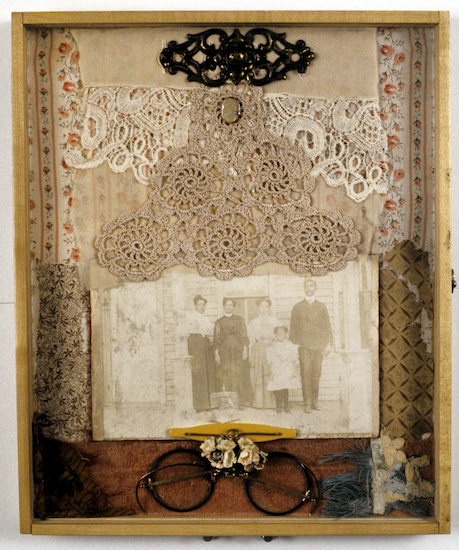Artist Birthday: Betye Saar
The unique assemblages of Betye Saar helped elevate the medium to fine art status when she began producing them in the late 1960s. Her works explore her African American identity, her African heritage, shared values and themes of world cultures with the US, and elements of the occult and Afro-Caribbean religions.
Artist Birthday for 30 July: Betye Saar (born 1926, United States)
Betye Saar is a standout African American artist who is renowned for her assemblages and prints.
 |
| Betye Saar, Grandma’s House, 1971. Mixed-media assemblage, 34 x 28 x 2 cm. Image courtesy of the artist, and permission for reproduction received from Ms Saar. © 2025 Betye Saar. (8S-19198) |
In assemblages such as Grandma’s House, Saar explores her family’s past in order to both reconstruct her personal experiences and to evoke a collective history common to all. The found objects she uses—old photographs, clothing, jewelry, and other household items—are purposeful, symbolic inclusions, their arrangement guided by the artist’s intuition. The sculpture box mimics the interior of an old attic trunk, its contents providing snippets of a larger narrative while remaining vague and mysterious.
The Civil Rights Movement of the 1960s galvanized black artists to push for a revival in exhibitions and study of African American art. Black artists had witnessed stagnation in their acceptance in the American art scene since the end of the Harlem Renaissance (ca. 1918–1930s). The reinvigoration within the African American artistic community led to the formation of the group Spiral in New York in 1963. Artists who had been active during the Harlem Renaissance as well as younger artists eventually joined Spiral. The styles ranged from Abstract Expressionism to Social Realism. The same ideological concerns dominated Spiral as they did the Harlem Renaissance.
There were wide differences of opinion about how black artists should go about the search for an individual identity for African American art. Some felt their art should be relevant to the black community and reflect recognized symbols and elements of their African ancestry. Others believed that style was a means to an end, and that any African American’s individual style, regardless of its “blackness,” could represent African American art. By 1965, Spiral had more or less ceased to exist. Although the group did not last as a leading force, it caused a resurgence of vitality in the African American artistic community. By the 1970s and 1980s, many black artists were represented in major galleries and museums around the country.
Three landmark shows in the 1970s furthered the study of African American art: Contemporary Black Artists in America (1971, Whitney Museum, New York); Two Centuries of Black American Art (1976, Los Angeles County Museum); and Afro-American Artists in Afro-America (1975, Museum of Fine Arts, Boston).
Saar has been a pioneer of feminist and African American nationalist aesthetics, whose lasting importance in the major recognition of African American art was secured when she “reclaimed” the Aunt Jemima figure with works like The Liberation of Aunt Jemima (1972). Saar was born in Los Angeles, and her family moved to Pasadena in the early 1930s. A city with a rich arts milieu, she participated in art classes and experimented with numerous approaches of making art. Initially studying design at Pasadena City College, she transferred to University of California at Los Angeles where she studied interior design.
After taking classes in printmaking, Saar turned to fine art, initially experimenting with prints. She began to explore combining her prints with photographs and objects often placing them in window frames. Deeply affected by the Watts uprising (1965) and murder of Martin Luther King, Jr (1968), her work began to express mystical, spiritual, often occult iconography. After seeing an exhibition of Surrealist assemblage artist Joseph Cornell (1903–1972), Saar too began to encase her collections of two- and three-dimensional objects in boxes. Saar’s process has been likened to a ritual by some art historians, and she consciously explored spiritual practices from a variety of cultures, including African, Caribbean, and Mexican. A viewing of the African art collection of the Field Museum in Chicago cemented her quest to connect imagery from other cultures in her works to explore the idea of a shared universality.
Saar collects objects from her trips throughout the world, and at flea markets in Los Angeles. She often collects old timey negative images and text about African Americans, which she incorporates into her works. She also exploits the use of personal family objects in assemblages that have as strong of a spiritual appeal as her so-called “occult” works. The most prevalent themes in Saar's work include childhood, the occult, memory, and Saar’s own African-American roots. Despite including specific references to the artist’s personal past, her art is designed to have a universal appeal, resonating with viewers of diverse backgrounds and uniting them through commonalities.
In the 1970s, Saar became active in the Women's Art Movement, being a strong voice for making the movement more inclusive of black and Latinx women. In 1975 her stature as an important African American artist was crowned with a solo exhibition at the Whitney Museum of American Art, New York. In 1988 she was invited by the US State Department to visit Asia on a cultural mission. Her leadership as a woman artist of color to this day has a resounding impact and influence on a new generation of African American artists.
Correlation to Davis program: Explorations in Art Kindergarten 2E, Unit 6 Explore Design, Lesson 4

Comments